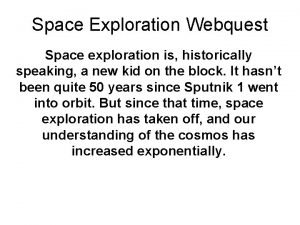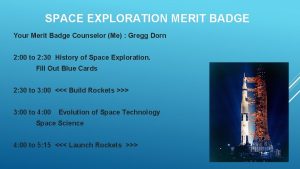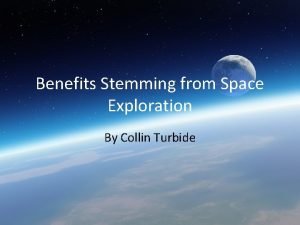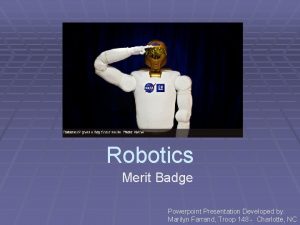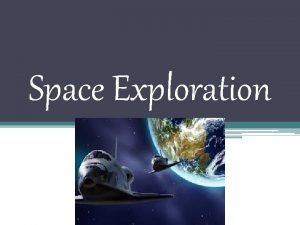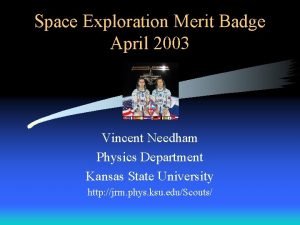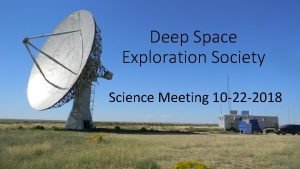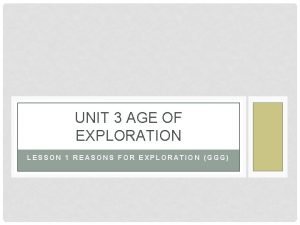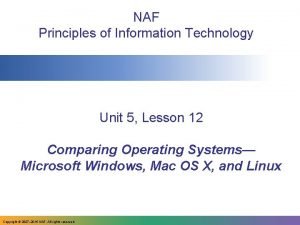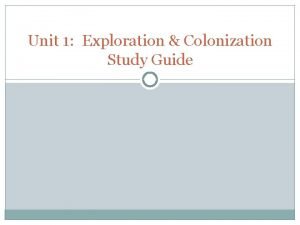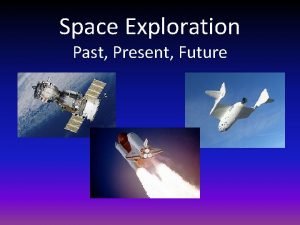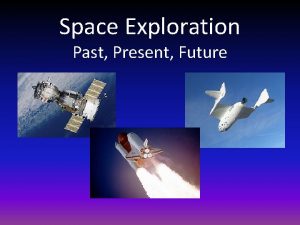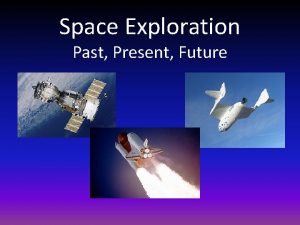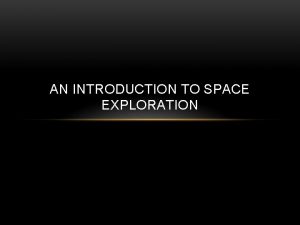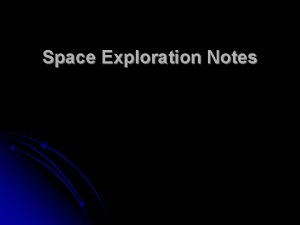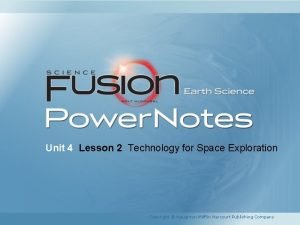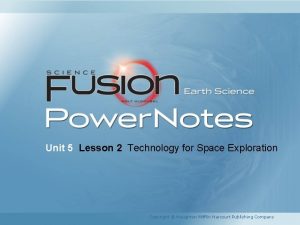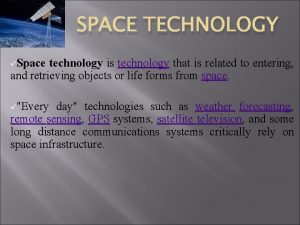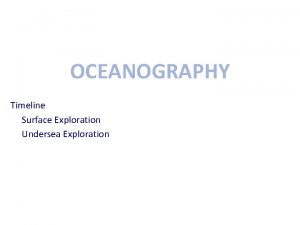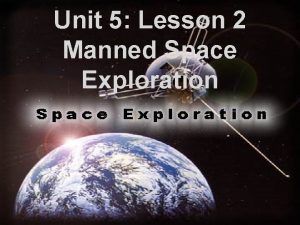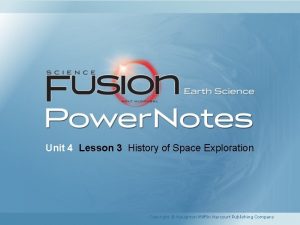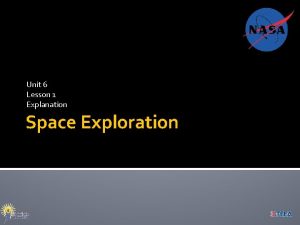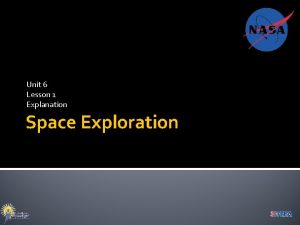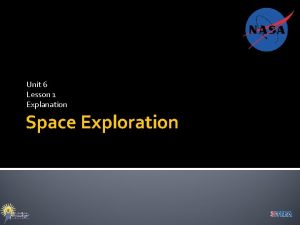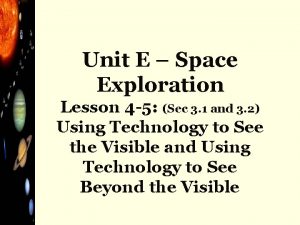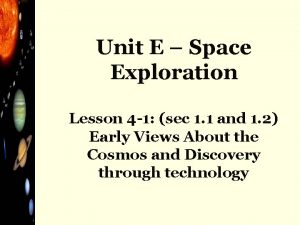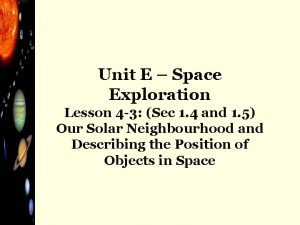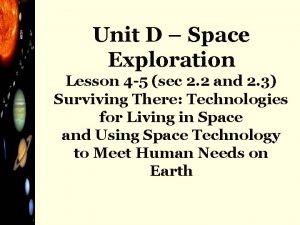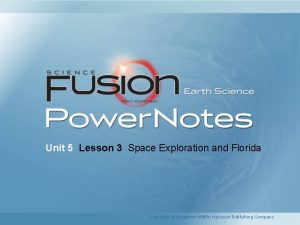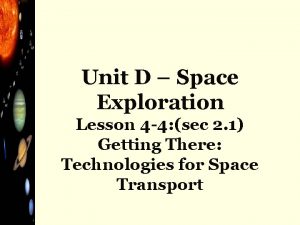Unit 9 Lesson 2 Technology for Space Exploration






















- Slides: 22

Unit 9 Lesson 2 Technology for Space Exploration Copyright © Houghton Mifflin Harcourt Publishing Company

Technology uses to explore space • Crewed technologies, such as spacecraft, have astronauts on board. They pilot the spacecraft or complete missions aboard the spacecraft. • Uncrewed technologies carry scientific instruments that collect data that is sent back to Earth where scientists analyze them.

A Rocket • A rocket is a machine that uses gas, often from burning fuel, to escape Earth’s gravitational pull. Rockets are used to launch vehicles into space. Copyright © Houghton Mifflin Harcourt Publishing Company

• In early missions, capsules containing the crews detached from the rockets and the rockets burned up. • Upon return, the capsules “splashed down” in the ocean and were recovered, but not reused. • https: //www. youtube. com/watch? v=Fz. Cs. DVf. PQqk • https: //www. youtube. com/watch? v=E-Vd 75 Ptg 9 I

Space Shuttle • A space shuttle is a reusable spacecraft that launches with the aid of rocket boosters and liquid fuel. It lands on Earth like an airplane.

Space Shuttle • A space shuttle carries astronauts and supplies back and forth into orbit around Earth. • Two white, solid rocket boosters (SRBs) help the shuttle reach orbit. These booster rockets detach and are reused.

Space Travel • For space travel, challenges include having sufficient supplies of air, food, water, and fuel for the long journey. • The spacecraft must be insulated from the intense cold of space and harmful radiation from the sun. • Experiencing weightlessness, astronauts find it difficult to eat, drink, and sleep without floating, and their muscles and bones weaken.

International Space Station

International Space Station • People live and work in space on space stations. A space station is a long-term crewed spacecraft on which scientific research can be carried out. • Currently, the International Space Station (ISS) is the only space station in Earth orbit. Six-member crews live aboard it for an average of six months.

International Space Station • Many scientific studies are conducted on the ISS, including the effects of weightlessness on the human body and observations of Earth systems. • https: //www. youtube. com/watch? v=T 1 h. WJfsoi. Kw

Exploring Space • Telescopes have been placed in Earth orbit to circumvent the distortion of light by Earth’s atmosphere. • The Hubble Space Telescope detects light from objects in space and sends images back to Earth. • The Chandra X-Ray Observatory and Compton Gamma-Ray Observatory were placed in space because Earth’s atmosphere blocks most X-rays and gamma rays.

Space Probe • A space probe is an uncrewed vehicle that carries scientific instruments to distant objects in space. Copyright © Houghton Mifflin Harcourt Publishing Company

Space Probe • Probes are useful for studying the atmospheres of the gas giant planets. • An atmospheric entry probe is dropped from a spacecraft into the planet’s atmosphere. • During its descent, it relays data back to the spacecraft. Copyright © Houghton Mifflin Harcourt Publishing Company

Orbiter • An orbiter is an uncrewed spacecraft that is designed to enter into orbit around another object in space.

Orbiter • Controllers on Earth can place a spacecraft into orbit around a distant planet or its moons. • Cameras and other instruments on the orbiter can photograph the planet’s surface and measure temperatures and surface features.

Lander • A lander is a craft designed to land on the surface of a body in space.

Lander • Landers have been placed successfully on the moon, Venus, and Mars, and on Saturn’s moon Titan. • The images taken by a lander are more detailed than those taken by an orbiter. Copyright © Houghton Mifflin Harcourt Publishing Company

Rover • A rover is a small vehicle that comes out of the lander and explores the surface of a planet or moon beyond the landing site. Copyright © Houghton Mifflin Harcourt Publishing Company

Rover • Both landers and rovers may have mechanical arms for gathering rock, dust, and soil samples. • In 2004, the twin rovers Spirit and Opportunity landed on Mars. They took images of the surface and found evidence of water below the surface. • In August 2012, the Curiosity rover landed on Mars and soon broadcast the first video footage from the planet.

Satellite • A satellite is any object in space that orbits another object. • An artificial satellite is any humanmade object placed in orbit around a body in space. • Examples of artificial satellites include remote-sensing satellites, navigation satellites, weather satellites, and communications satellites.

Satellites • Weather satellites help scientists track storms and issue advance weather warnings. • They also monitor environmental conditions, such as changes in ocean temperatures. • Remote-sensing satellites help scientists study Earth from space. They are used to map the ocean floor, identify sources of pollution, determine the size of ice caps, and map the types of forests.

Satellites • Navigation satellites, which includes the Global Positioning System (GPS), can help pinpoint a user’s exact location on earth. • Communication satellites transmit television and telephone signals over long distances.
 Unit 3 career exploration lesson 9 health science
Unit 3 career exploration lesson 9 health science Space exploration webquest
Space exploration webquest Space exploration merit badge
Space exploration merit badge Space exploration conclusion
Space exploration conclusion The father of modern rocketry
The father of modern rocketry Kayaking merit badge powerpoint
Kayaking merit badge powerpoint Http://history.nasa.gov/sputnik/
Http://history.nasa.gov/sputnik/ Space exploration merit badge
Space exploration merit badge Deep space exploration society
Deep space exploration society Ggg
Ggg Unit 3 lesson 12 information technology
Unit 3 lesson 12 information technology Unit 2 exploration and georgia colonization
Unit 2 exploration and georgia colonization Unit 1 careers
Unit 1 careers Unit 1 exploration and colonization
Unit 1 exploration and colonization Right triangle trigonometry
Right triangle trigonometry Unit 6 review questions
Unit 6 review questions Fspos
Fspos Novell typiska drag
Novell typiska drag Tack för att ni lyssnade bild
Tack för att ni lyssnade bild Ekologiskt fotavtryck
Ekologiskt fotavtryck Shingelfrisyren
Shingelfrisyren En lathund för arbete med kontinuitetshantering
En lathund för arbete med kontinuitetshantering Särskild löneskatt för pensionskostnader
Särskild löneskatt för pensionskostnader

